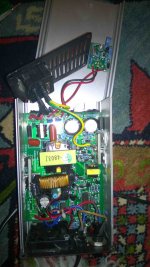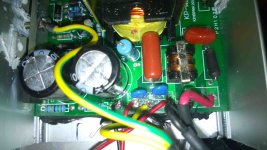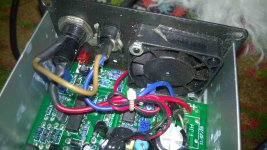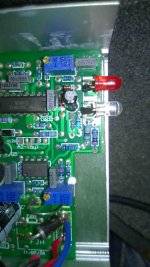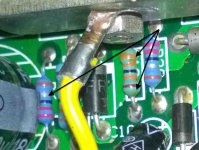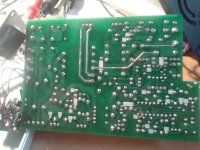fschoova
10 mW
- Joined
- Oct 27, 2014
- Messages
- 20
View attachment 5Hello everyone,
Please forgive me for my bad english.
I decided to post on this fantastic forum to expose my ping charger(s) problem(s).
It seems that I'm not the only one in this situation.
I bought about two years ago LIFEPO4 batteries, one 48V15AH + two 24V10AH and diodes to possibly put them in serie.
I also bought 4 chargers, two 48v2AH and two 24v4AH.
I went about 100 times to work by bike, using a front wheel with a "ninecontinent" hub motor on a triban5. (80km per day)
Perfect till last month during which both my chargers stopped working.
I can confirm the problem because a friend of mine bought also last year batteries from ping and chargers 2AH and 5AH and that I could recharge my batterie with the 2AH one. The charger model is different, I can see trough the ventilation grid some component that I don't find on my own.
The first charger stopped working after about 5 recharges. The symptom is simply when connecting the battery the red led turn on but the recharge doesn't start. No ventilation, no burn smell, the circuitry is clean, no trace of burned component, the fuses are ok...
I tested the cables etc... The second charger stopped working after less than 100 recharge. Same symptoms.
I noticed that the "new" charger (from the friend) is working a bit differently as the red led does not blink when connecting the battery without the main power.
So I was planning to buy new chargers but I'm not convinced that the problem has no solution. Also when searching on the net I found many people speaking about the same symptom/problem but I was not able to find the solution.
What I found is that DNMUN expertise seemed quite relevant and I contacted him directly. He kindly advice me to post on this forum to maybe find a solution for all between us.
He also advice me to post pictures.
I jpeg compressed them while keeping a good resolution (some are blured).
Here are some of them: please note that mess in the the white conductive paste is due to the removing of the circuitry from the aluminium box.
I can post other pictures, make some measurements... Thanks to all who can help to understand what happened.
Fred
Please forgive me for my bad english.
I decided to post on this fantastic forum to expose my ping charger(s) problem(s).
It seems that I'm not the only one in this situation.
I bought about two years ago LIFEPO4 batteries, one 48V15AH + two 24V10AH and diodes to possibly put them in serie.
I also bought 4 chargers, two 48v2AH and two 24v4AH.
I went about 100 times to work by bike, using a front wheel with a "ninecontinent" hub motor on a triban5. (80km per day)
Perfect till last month during which both my chargers stopped working.
I can confirm the problem because a friend of mine bought also last year batteries from ping and chargers 2AH and 5AH and that I could recharge my batterie with the 2AH one. The charger model is different, I can see trough the ventilation grid some component that I don't find on my own.
The first charger stopped working after about 5 recharges. The symptom is simply when connecting the battery the red led turn on but the recharge doesn't start. No ventilation, no burn smell, the circuitry is clean, no trace of burned component, the fuses are ok...
I tested the cables etc... The second charger stopped working after less than 100 recharge. Same symptoms.
I noticed that the "new" charger (from the friend) is working a bit differently as the red led does not blink when connecting the battery without the main power.
So I was planning to buy new chargers but I'm not convinced that the problem has no solution. Also when searching on the net I found many people speaking about the same symptom/problem but I was not able to find the solution.
What I found is that DNMUN expertise seemed quite relevant and I contacted him directly. He kindly advice me to post on this forum to maybe find a solution for all between us.
He also advice me to post pictures.
I jpeg compressed them while keeping a good resolution (some are blured).
Here are some of them: please note that mess in the the white conductive paste is due to the removing of the circuitry from the aluminium box.
I can post other pictures, make some measurements... Thanks to all who can help to understand what happened.
Fred


